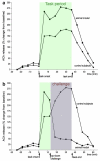Cholinergic contributions to the cognitive symptoms of schizophrenia and the viability of cholinergic treatments
- PMID: 21156184
- PMCID: PMC3920544
- DOI: 10.1016/j.neuropharm.2010.12.001
Cholinergic contributions to the cognitive symptoms of schizophrenia and the viability of cholinergic treatments
Abstract
Effective treatment of the cognitive symptoms of schizophrenia has remained an elusive goal. Despite the intense focus on treatments acting at or via cholinergic mechanisms, little remains known about the dynamic cholinergic abnormalities that contribute to the manifestation of the cognitive symptoms in patients. Evidence from basic neuroscientific and psychopharmacological investigations assists in proposing detailed cholinergic mechanisms and treatment targets for enhancement of attentional performance. Dynamic, cognitive performance-dependent abnormalities in cholinergic activity have been observed in animal models of the disorder and serve to further refine such proposals. Finally, the potential usefulness of individual groups of cholinergic drugs and important issues concerning the interactions between pro-cholinergic and antipsychotic treatments are addressed. The limited evidence available from patient studies and animal models indicates pressing research needs in order to guide the development of cholinergic treatments of the cognitive symptoms of schizophrenia.
Copyright © 2010 Elsevier Ltd. All rights reserved.
Figures



References
-
- Adler L, Olincy A, Waldo M, Harris J, Griffith J, Stevens K, Flach K, Nagamoto H, Bickford P, Leonard S, Freedman R. Schizophrenia, sensory gating, and nicotinic receptors. Schizophr. Bull. 1998;24:189–202. - PubMed
-
- Arnold H, Burk J, Hodgson E, Sarter M, Bruno J. Differential cortical acetylcholine release in rats performing a sustained attention task versus behavioral control tasks that do not explicitly tax attention. Neuroscience. 2002;114:451–460. - PubMed
-
- Barak S. Modeling cholinergic aspects of schizophrenia: focus on the anti-muscarinic syndrome. Behav. Brain Res. 2009;204:335–351. - PubMed
Publication types
MeSH terms
Substances
Grants and funding
LinkOut - more resources
Full Text Sources
Medical

